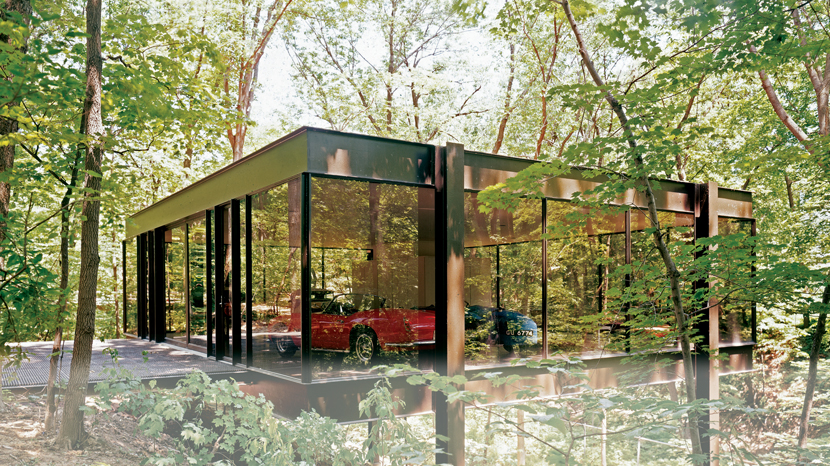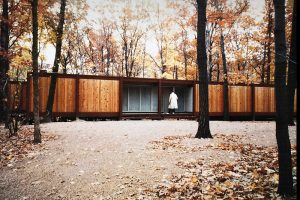
Movie Houses: Ferris Bueller’s Day Off (1986), Cameron Frye’s House
There are very few people out there who do not recall that pivotal moment in the John Hughes film Ferris Bueller’s Day Off when Ferris’s friend Cameron (Alan Ruck) knocks his father’s cherished Ferrari off its jack sending it crashing through a glass wall and into the ravine below.
 The house used as Cameron’s family home in the movie is known as The Rose House and Pavilion, a 5,300 sq. ft home, located at 370 Beech Street in the woods of Highland Park, just north of Chicago. The house was designed and built in 1953 by architect James Speyer, a protégé of Mies Van der Rohe. The separate, complimentary glass-walled pavilion which housed Cameron’s father’s prized 1961 Ferrari 250 GT California Spyder convertible was added in 1974. Both buildings are spectacularly cantilevered 30 feet in the air over the edge of the wooded ravine, which played out well for the scene. Interestingly enough, this separate pavilion had been originally designed as a personal car showroom for the property’s original owner Ben Rose.
The house used as Cameron’s family home in the movie is known as The Rose House and Pavilion, a 5,300 sq. ft home, located at 370 Beech Street in the woods of Highland Park, just north of Chicago. The house was designed and built in 1953 by architect James Speyer, a protégé of Mies Van der Rohe. The separate, complimentary glass-walled pavilion which housed Cameron’s father’s prized 1961 Ferrari 250 GT California Spyder convertible was added in 1974. Both buildings are spectacularly cantilevered 30 feet in the air over the edge of the wooded ravine, which played out well for the scene. Interestingly enough, this separate pavilion had been originally designed as a personal car showroom for the property’s original owner Ben Rose.
In 2009, Ben Rose passed away, leaving the future of this very unique property uncertain. At that point, the house was in physical despair and basically was lacking basic standards expected for today’s living needs. The cutting-edge design of the floor-to-ceiling windows which provided the homes signature uncompromised views, were all constructed of single-pane glass which were not conducive to extreme Chicago weather conditions. Heating and cooling had been added in the past in an attempt to combat the extreme temperature fluctuations but had been installed to the home’s exposed under structure, ensuring the system was extremely inefficient and expensive to operate.
Following the 2009 death of Ben Rose, the property was listed for a not unreasonable $2.3 million, but the very features that made the house unique were found to be intimidating to perspective buyers who were interested in the land, but not the structures. In 2011, the home’s price had been reduced to $1.65 million and in June, 2014, the property containing the two separate buildings, finally sold for $1.06 million, well below the original asking price.
The new owners have embarked on an extensive renovation and expansion plan for the property which includes replacement of all windows with thermal glass, insulating the ceilings and floors of the house and adding a heated floor hot water system, full restoration of the home’s steel beam structure and the construction of a new underground living space and garage. This new construction, which contains a family room, laundry room, storage and two-car garage has been designed to be sympathetically submerged, effectively camouflaging this component to not compromise Speyer’s original 1953 design of the home.